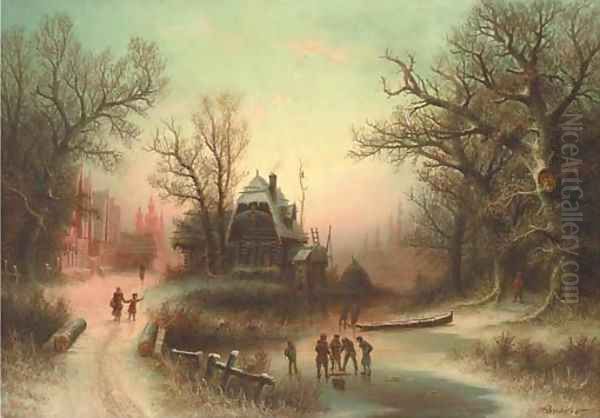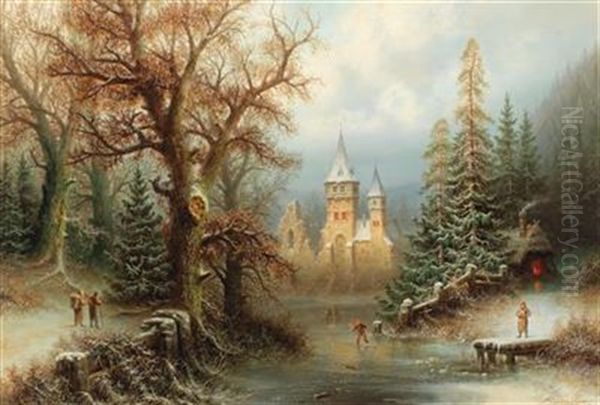Albert Bredow (1828-1899) stands as a notable, if sometimes overlooked, figure in the annals of 19th-century art, a painter whose life and career bridged the artistic currents of Germany and Russia. Born in Germany, Bredow would later find his artistic home and make his most significant contributions in Russia, becoming renowned for his evocative Romantic landscape paintings, particularly those capturing the stark beauty and melancholic allure of winter. Beyond the canvas, he also distinguished himself as a talented stage designer and decorative artist, lending his vision to some of Russia's most prestigious theatres. His dual identity as a German émigré and a Russian-acclimatized artist offers a fascinating lens through which to view the cultural exchanges and artistic developments of his time.
Early Influences and the Spirit of Romanticism
Born in 1828 in Germany, Albert Bredow's formative years would have coincided with the flourishing of Romanticism, a movement that had profoundly reshaped the artistic, literary, and intellectual landscape of Europe. German Romanticism, in particular, with standard-bearers like Caspar David Friedrich (1774-1840), emphasized emotion, individualism, the glorification of the past and nature, and a preference for the medieval over the classical. Friedrich’s atmospheric landscapes, often imbued with a sense of spiritual awe, solitude, and the sublime power of nature, undoubtedly formed part of the artistic ether in which Bredow developed. Artists like Carl Blechen (1798-1840), known for his more dramatic and sometimes unsettling landscapes, and Adrian Ludwig Richter (1803-1884), celebrated for his idyllic scenes, also contributed to the rich tapestry of German art during this period.
While specific details of Bredow's early training in Germany are not extensively documented in readily available sources, it is reasonable to assume he absorbed these Romantic sensibilities. The movement's focus on subjective experience and the emotional resonance of the natural world would become hallmarks of his later work, especially his signature winter scenes. The allure of distant lands and the search for new artistic frontiers, also a Romantic trope, may have played a role in his eventual move to Russia.
A New Canvas: Russia and the Theatrical World

In 1852, Albert Bredow made a pivotal decision to relocate to Russia. This move placed him in a vibrant and evolving artistic environment. Imperial Russia, particularly its cultural capitals of Moscow and St. Petersburg, was a hub of artistic activity, with a burgeoning school of national painting and a deep appreciation for the performing arts. Bredow quickly established himself not only as a painter but also as a sought-after stage designer and decorative artist.
His talents found expression in some of the most revered theatrical institutions of the era. He contributed designs and decorations for the Bolshoi Theatre in Moscow, a legendary venue for opera and ballet. He also worked for the Maly Theatre in Moscow, known for its dramatic productions. In St. Petersburg, his skills were employed by the illustrious Mariinsky Theatre, another cornerstone of Russian performing arts. Stage design in 19th-century Russia was an elaborate affair, often characterized by opulent sets and a desire for historical or fantastical realism, providing a fertile ground for an artist with Bredow's Romantic inclinations. His work in these theatres would have involved creating immersive visual worlds for narratives unfolding on stage, a task that complemented his landscape painting by requiring a keen sense of atmosphere and composition.
One of his notable theatrical contributions was his involvement in the stage design for the ballet "Konyok-Gorbunok" (The Little Humpbacked Horse). This landmark Russian ballet, with music by Cesare Pugni and original choreography by Arthur Saint-Léon, premiered on December 15, 1864, at the Imperial Bolshoi Kamenny Theatre in St. Petersburg (a predecessor to the Mariinsky). Bredow's role in designing the scenery for such a significant production underscores his standing in the Russian theatrical community. The fantastical nature of "The Little Humpbacked Horse," based on a Russian fairy tale, would have allowed Bredow ample opportunity to create imaginative and visually striking stage pictures.
The Painter of Winter: Bredow's Romantic Landscapes
While his theatrical work was significant, Albert Bredow is perhaps most celebrated for his easel paintings, particularly his romanticized depictions of winter. His canvases frequently portray snow-covered landscapes, frozen rivers, and figures braving the chill of the season. These are not mere topographical records but are imbued with a distinct mood, often melancholic, contemplative, and deeply atmospheric. The influence of the Romantic movement is palpable in these works, which evoke a sense of solitude, the passage of time, and the quiet majesty of nature in its most austere state.

His palette often leaned towards cool blues, grays, and whites, punctuated by the warm tones of a setting sun or the subtle colors of human attire. The interplay of light and shadow on snow, the delicate tracery of bare branches against a winter sky, and the depiction of human activity within these vast, often stark, environments are characteristic features of his style. Works descriptively titled such as "Winter Landscape," "Romantic Winter Landscape," and "Castle in the Snow" (or similar themes) capture the essence of his focus.
One specific painting that is often cited is "Procession at a Snowy Monastery," completed in 1887. This work likely combines his skill in rendering winter scenery with a narrative element, depicting a religious procession moving through a snow-laden monastic setting. Such a scene would resonate with Russian cultural and spiritual traditions, where monasteries often hold significant historical and emotional importance, and winter is a defining aspect of the national experience. The painting would likely convey a sense of solemnity and enduring faith amidst the harshness of the elements.
Bredow in the Context of European and Russian Landscape Painting
Albert Bredow's artistic output can be situated within broader trends in 19th-century European landscape painting. His German origins connect him to the legacy of Caspar David Friedrich, whose symbolic and spiritual approach to nature set a high bar for Romantic landscape. However, Bredow's work, particularly after his move to Russia, also absorbed elements of his adopted homeland's artistic sensibilities.
In Russia, landscape painting was gaining increasing prominence throughout the 19th century. Artists like Sylvester Shchedrin (1791-1830), though working earlier and often depicting Italian scenes, helped establish landscape as a worthy genre. Later, the Peredvizhniki (the Wanderers or Itinerants) movement, which gained momentum in the latter half of the century, saw artists like Alexey Savrasov (1830-1897) and Isaac Levitan (1860-1900) create deeply lyrical and emotionally resonant depictions of the Russian landscape. Savrasov's iconic "The Rooks Have Arrived" (1871) captures the subtle beauty of early spring, while Levitan became known as the master of the "mood landscape," evoking profound emotional responses through his depictions of Russia's vast and often melancholic nature.
While Bredow was not formally part of the Peredvizhniki, his work shares with these artists a deep engagement with the character of the land and its atmospheric qualities. His focus on winter, however, distinguishes him somewhat. While other Russian artists certainly painted winter, Bredow made it a central theme, exploring its varied facets with a Romantic sensibility that perhaps retained a more direct link to his German artistic heritage. His winter scenes can also be seen in a longer tradition of depicting winter, stretching back to artists like Pieter Bruegel the Elder (c. 1525-1569) with his famous "Hunters in the Snow."
Internationally, the Romantic impulse in landscape painting was widespread. In England, J.M.W. Turner (1775-1851) pushed the boundaries of representation with his dramatic and often abstract depictions of light and atmosphere, while John Constable (1776-1837) focused on the naturalistic portrayal of the English countryside. In France, artists of the Barbizon School, such as Théodore Rousseau (1812-1867) and Jean-François Millet (1814-1875), emphasized a more direct and unidealized observation of nature and rural life, paving the way for Impressionism. Bredow's work, with its blend of observation and romantic mood, occupies its own niche within this diverse European landscape tradition. His contemporary, the Russian-Armenian marine painter Ivan Aivazovsky (1817-1900), also worked in a Romantic style, though his focus was primarily on the dramatic power of the sea.
A Spiritual Dimension and Personal Life
The provided information suggests that Albert Bredow undertook several significant journeys, visiting Rome, Santiago de Compostela, and Jerusalem. These destinations are major centers of Christian pilgrimage, indicating a profound religious and spiritual dimension to his life. Such travels would have exposed him to diverse cultures, landscapes, and artistic traditions, potentially enriching his worldview and, subtly or overtly, influencing his art. The experience of pilgrimage often involves introspection and a search for meaning, themes that resonate with the contemplative quality found in many of his paintings.
It is also mentioned that he may have lived in poverty while steadfastly maintaining his faith and artistic practice. If accurate, this detail paints a picture of an artist deeply committed to his calling, undeterred by material hardship. This dedication, combined with his spiritual interests, adds another layer to our understanding of the man behind the art, suggesting an inner life that fueled his creative endeavors. The melancholic beauty of his winter landscapes might, in part, reflect this personal journey of faith and perseverance.
Artistic Connections and Creative Milieu
While the provided texts do not detail specific close collaborations or memberships in formal artistic groups beyond his theatrical work, Bredow operated within a dynamic artistic milieu. His work as a stage designer would have brought him into contact with composers, librettists, choreographers, and other visual artists involved in theatrical production. The collaborative nature of theatre means he would have been part of a creative team, contributing to a unified artistic vision.
In the broader St. Petersburg and Moscow art scenes, he would have been aware of, and likely interacted with, other painters. The Imperial Academy of Arts in St. Petersburg was a dominant institution, though movements like the Peredvizhniki emerged partly in opposition to its academic strictures. Artists like Ivan Kramskoi (1837-1887), a leading figure of the Peredvizhniki, or the great realist Ilya Repin (1844-1930), were his contemporaries, shaping the Russian art world. While Bredow's style remained more consistently Romantic, he was undoubtedly part of the larger artistic discourse of the time. His German origins might have also allowed him to act as a conduit for artistic ideas between Germany and Russia.
Legacy and Enduring Appeal
Albert Bredow passed away in 1899, leaving behind a significant body of work that continues to be appreciated for its technical skill and evocative power. His paintings are held in private collections and museum inventories across the globe, a testament to their enduring appeal. He is recognized as an important contributor to Russian art history, particularly for his specialization in Romantic winter landscapes, and for his role in the rich tradition of Russian stage design.
His ability to capture the unique atmosphere of winter – its quietude, its stark beauty, and its capacity to evoke deep emotion – ensures his place among the notable landscape painters of the 19th century. The "melancholy and contemplative atmosphere" noted in his work speaks to a universal human experience, making his paintings relatable even to contemporary audiences. He successfully synthesized his German artistic roots with the cultural and natural environment of his adopted Russia, creating a distinctive artistic voice.
In conclusion, Albert Bredow was an artist of considerable talent and quiet dedication. His romantic winter landscapes offer a poignant vision of nature, while his contributions to the Russian theatre highlight his versatility. He navigated the artistic currents of two cultures, leaving a legacy that enriches our understanding of 19th-century European art. His work serves as a reminder of the power of art to capture not just the physical appearance of the world, but also its emotional and spiritual resonance, particularly through the evocative and often challenging beauty of winter. His paintings invite contemplation and offer a window into a soul that found profound expression in the hushed, snow-covered vistas of his imagination.